Carbon Reduction Plan
Issue Date 29.09.2025 Rev 008
Commitment to Achieving Net Zero
Stepnell Ltd is committed to achieving Net Zero emissions by 2050.
We have set targets to achieve Net Zero for Scope 1 and 2 by 2039 and to achieve Net Zero across our value chain carbon (Scope 3) by 2050.
Baseline Emissions Footprint
Baseline emissions are a record of the greenhouse gases that have been produced in the past and were produced prior to the introduction of any strategies to reduce emissions. Baseline emissions are the reference point against which emissions reduction can be measured. The data is obtained from the Streamlined Energy & Carbon Reporting Regulations (SECR) reports.
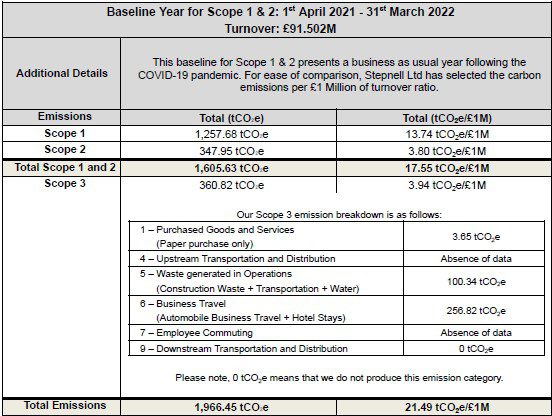
Downstream transportation and distribution is not relevant to Stepnell Ltd as there is no transportation or distribution associated with the assets delivered.
During the financial year 2022-2023, we developed and introduced new reporting processes and improved data collection to capture our emissions, notably categories 4, 5 and 7 of Scope 3. Our Scope 3 baseline year is therefore aligned to the financial year 2022-2023 (1st April 2022 – 31st March 2023). Please refer to the table below.
For ease of comparison Stepnell has selected the carbon emissions per £1 Million of turnover ratio.
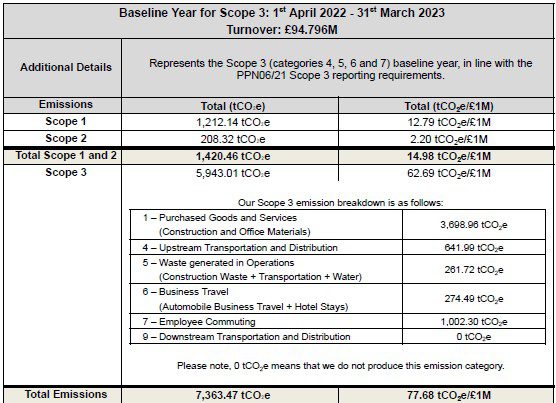
Downstream transportation and distribution is not relevant to Stepnell Ltd as there is no transportation or distribution associated with the assets delivered.
Emissions Reporting Year 1st April 2023 – 31st March 2024
For ease of comparison Stepnell has selected the carbon emissions per £1 Million of turnover ratio.
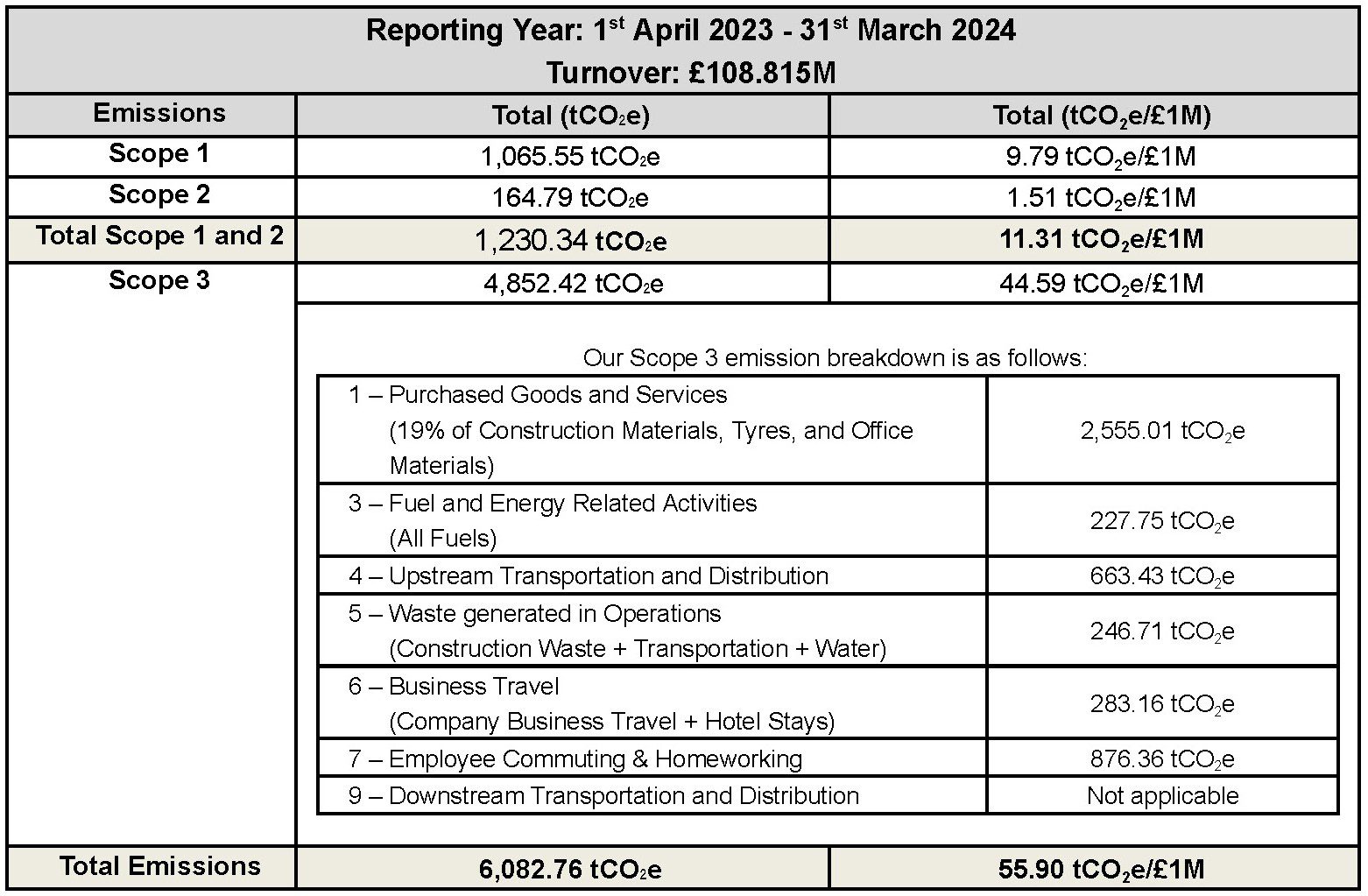
Downstream transportation and distribution is not relevant to Stepnell Ltd as there is no transportation or distribution associated with the assets delivered.
Data for the 2023-2024 reporting period has been updated since the previous publication of this document following minor amendments made during the ISO 14064 verification process. Scope totals and intensity metrics both before and after the verification are shown in the table below.

Current Emissions Reporting
For ease of comparison Stepnell has selected the carbon emissions per £1 Million of turnover ratio.
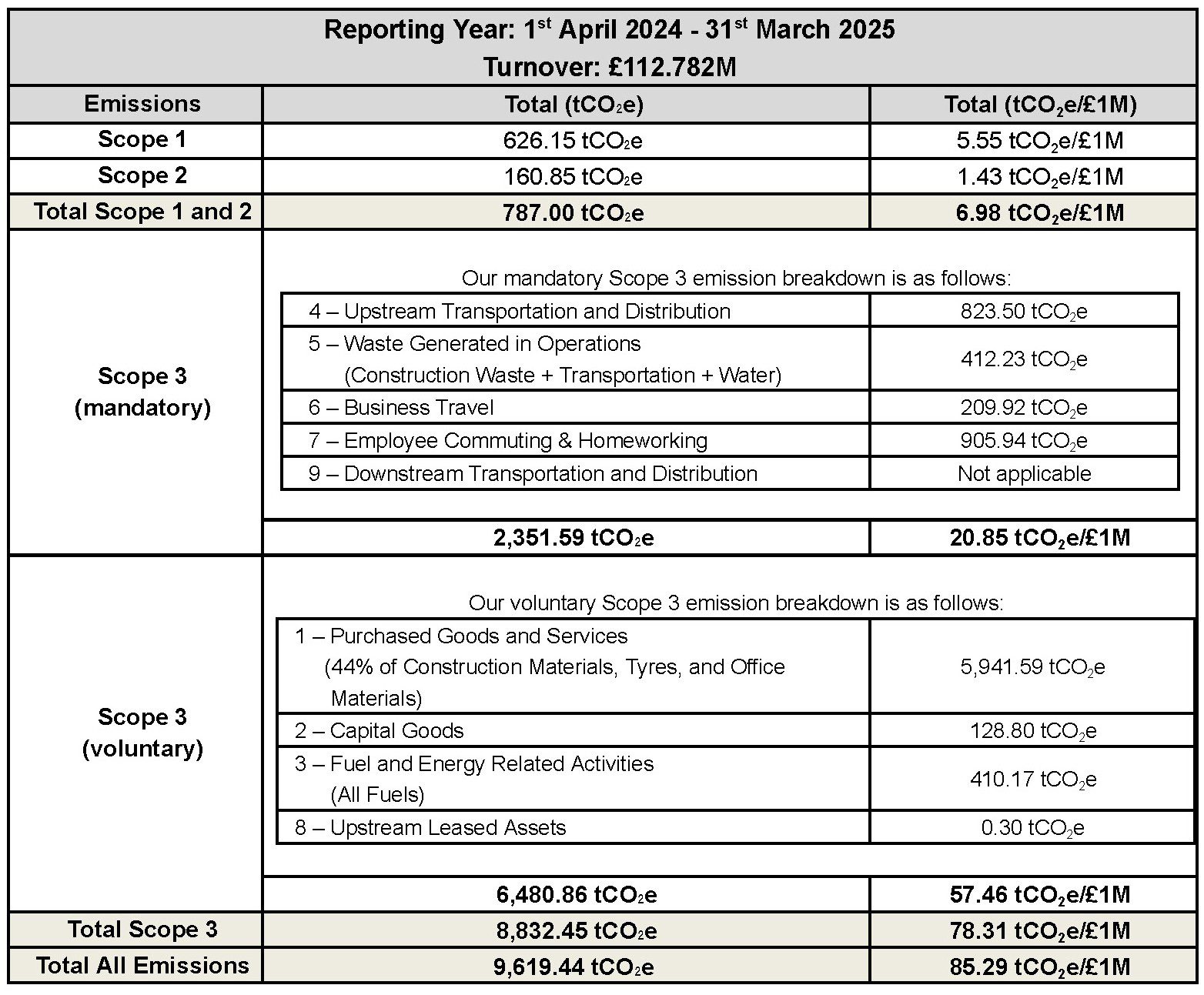
Downstream transportation and distribution is not relevant to Stepnell Ltd as there is no transportation or distribution associated with the assets delivered.
Emissions Reduction Targets
We have surpassed our Scope 1 and 2 target made last financial year which were to achieve a Scope 1 and 2 of 9.72 tCO₂e/ £1M by 2026, achieving 6.98 tCO₂e/ £1M, a 60.23% from our baseline year 2021-2022. We have worked hard to improve the accuracy and completeness of our Scope 3 emissions reporting (details provided below), as a result our total Scope 3 emissions have increased and we have not yet met the target set last year of 56.94 tCO2e/£1M, our Scope 3 emissions for 2024-2025 are 85.29 tCO₂e/£1M, a 9.80% increase from our baseline year 2022-2023.
We have achieved a significant improvement in the completeness and accuracy of our Scope 3 emissions reporting for 2024-2025, key points of note are detailed below:
- Category 1 Purchased Goods and Services – We achieved a step-change in the granularity of our Scope 3 reporting. The breadth of construction materials included in our emissions calculations more than doubled, representing the most significant improvement in our data maturity and providing a robust foundation for targeting embodied carbon reductions across our supply chain. The methodology of emissions calculation has also improved, applying a hierarchy of data sources:
- Product specific Environmental Product Declarations (EPDs)
- UK Generic EPDs
- Circular Ecology (2024) Inventory of Carbon & Energy (ICE) Database V4.0
- 2024 UK Government Conversion Factors for Company Reporting
This has significantly improved the accuracy of our reporting in this category and enables us to demonstrate reduction of emissions in future years through use of low carbon materials.
- Category 2 Capital Goods – For 2024-2025 we have included capital purchases in our emissions reporting, this has not previously been reported.
- Category 3 Fuel and Energy Related Activities – Reporting of emissions in this category has been expanded to include all fuel types, previously this only included electricity and gas.
- Category 8 Upstream Leased Assets – For 2024-2025 we have included upstream leased assets in our emissions reporting, this has not previously been reported.
In order to continue our progress to achieving Net Zero, we will continue to work to our agreed carbon reduction targets and project that our carbon reduction will follow the below trajectory:
- Emissions from Scope 1 and 2 will decrease to 507.92 tCO₂e and 5.55 tCO₂e/£1M turnover by 2029-2030. This is a reduction of 68.37% from our baseline year 2021-2022.
- Carbon emissions from Scope 3 (8 subset categories: purchased goods and services, , capital goods, fuel and energy related activities, upstream transportation and distribution, waste generated in operations, business travel, employee commuting, and upstream leased assets) will decrease to 4,568.69 tCO₂e and 48.19 tCO₂e/£1M turnover by 2029-2030. This is a reduction of 14.50 tCO₂e/£1M turnover and 24.92% from our baseline year 2022-2023.
- Note that Scope 3 emissions reduction targets are set from the baseline year 2022-2023. As our completeness and accuracy of reporting against this scope improves we anticipate an increase in our absolute Scope 3 emissions, as such we will review the requirement to rebaseline at the end of the next financial year.
Progress against these targets can be seen in the graphs below:
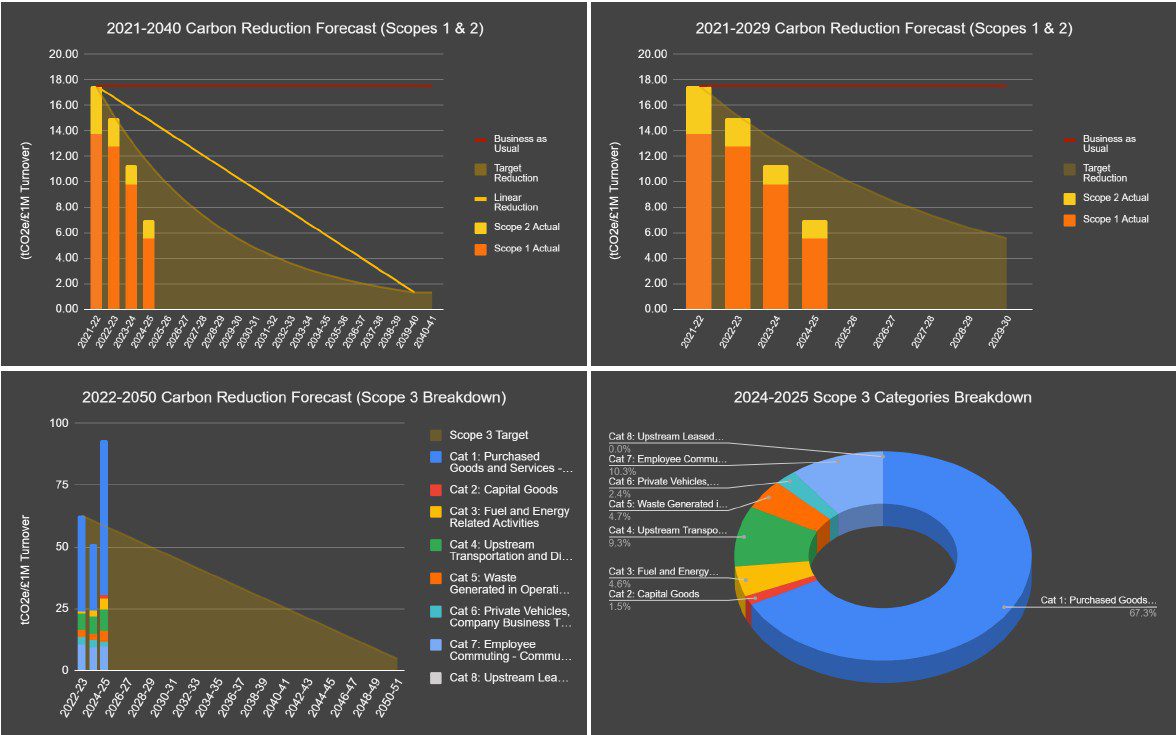
Carbon Reduction Projects
Completed Carbon Reduction Initiatives
The following sustainability management measures and projects have been completed or implemented since the 2021-2022 baseline. The Scope 1 and 2 carbon emission reduction achieved by these schemes equate to 10.57 tCO2e/£1M, a 60.23% reduction against the 2021-2022 baseline and the measures will be in effect when performing the contract. As mentioned above, we are reporting an increase in our Scope 3 emissions as a direct result of our improved data completeness and accuracy.
Implemented carbon reduction projects include:
Strategy & Governance
- Advanced our formal Carbon Reduction Plan, in line with PPN 06/21, to ensure auditable progress towards our Net Zero by 2050 target.
- A thorough review and redevelopment of the Sustainability Forum’s core objectives was undertaken and endorsed at both SLT and Board level, ensuring the Forum is strategically aligned to deliver our Carbon Reduction Plan and drive the overarching sustainability strategy for the business by uniting key leaders from across our operations.
- Embedded sustainability practices across our projects through tools such as our Project Sustainability Management Workbook.
Verification & Certification
- Achieved independent, second-party verification of our 2023-2024 emissions data by Robinson Management Services and third-party verification by NQA of our 2023-2024 emissions data to the ISO 14064-1 standard, assuring the accuracy and integrity of our reporting.
- Successfully obtained and maintained our internationally recognised management system certifications for Energy Management (ISO 50001) and Environmental Management (ISO 14001).
Data & Systems Integrity
- Enhanced the accuracy and scope of our data collection processes by leveraging established platforms such as SmartWaste and Biosite, with specific improvements in capturing emissions from waste, fuel, and EV charging.
- Strengthened data integrity by supplementing these systems with emissions data sourced directly from our supply chain, a crucial step that improves accuracy while building collaborative relationships and setting clear sustainability reporting expectations with our partners.
Operational Achievements
Property & Energy:
- Delivered a landmark refurbishment of our Lawford Road head office, achieving a substantial upgrade of its Energy Performance Certificate (EPC) rating from E to A.
- Advanced our commitment to clean energy by ensuring all electricity procured through our preferred supplier, E.ON, is from 100% renewable sources.
- Reduced overall power consumption from our IT estate by 70% through the virtualisation of our servers and transitioned to the carbon-neutral Google Workspace cloud environment.
- Cut gas consumption in our joinery workshop and reduced wood waste by 90% by converting offcuts into heating fuel with a new briquette machine and wood burner.
Fleet & Transport:
- Transitioned the company car list to exclusively feature electric and hybrid vehicles.
- Restructured the employee car allowance to provide a clear financial incentive for choosing low-emission personal vehicles.
- Increased the number of electric car charging points available to company car users at our offices.
Sustainable Construction:
- Undertook a comprehensive embodied carbon assessment on a new build school project, utilising One Click LCA software to identify carbon-intensive methods and materials and inform reduction strategies.
- Updated our procurement policy to mandate that all newly purchased, fire-rated site cabins must meet the ‘Eco-Cabin’ standard for superior energy performance.
- Pioneered the use of hybrid battery and generator power systems on multiple construction sites, significantly reducing diesel consumption and generator runtime.
- All sites continue to source materials from sustainable sources wherever possible, such as timber certified by the Forest Stewardship Council (FSC).
- Conducted supply chain reviews to maximise the potential for reuse and recycling, while continuing to source materials from certified sustainable sources (e.g., FSC timber).
Industry Leadership & Client Services
- Maintained our signatory status to the ‘Contractors Declare’ pledge, reaffirming our ongoing commitment to industry-wide climate action.
- Continued to support clients’ decarbonisation goals through our specialist subsidiary, Step Energy, which delivers bespoke renewable and energy-efficient technology solutions.
Emissions Reduction and Energy Efficiency Actions for Future Implementation
The following energy efficiency actions are under consideration for implementation or are in progress during the financial year 2025-2026:
Strategy & Governance
- Develop and launch an overarching Sustainability Strategy to provide a clear, actionable roadmap for emissions reduction.
- Develop and secure approval for a Net Zero target that is aligned with the Science Based Targets initiative (SBTi) framework methodology.
- Review, and update the company’s core Sustainability Key Performance Indicators (KPIs) to effectively measure reduction progress and finalise the development of project energy intensity metric targets (kWh/m²) to drive down energy use in completed projects.
- Achieve Silver-level company certification in the Carbon Literacy Training scheme to enhance knowledge and drive behavioural change across the business.
Verification & Certification
- Achieve independent, second-party verification of our 2024-2025 emissions data by Robinson Management Services and third-party verification of our 2024-2025 emissions data to the ISO 14064-1 standard to assure reporting integrity.
- Maintain our internationally recognised management system certifications for Energy Management (ISO 50001) and Environmental Management (ISO 14001).
- Investigate obtaining certification to PAS 2080
- Investigate mandating certification of our waste management subcontractors to PAS 408
- Achieve Pledger status of the Carbon Reduction Code
Data, Analysis & Reporting
- Develop a tiered supply chain engagement strategy to favour suppliers with a Net Zero Carbon target, and improve the reporting of emissions data, enabling targeted Scope 3 emission reductions.
- Expand the use of whole-life carbon assessments to deliver a calculated carbon figure for projects at handover.
- Expand the use of embodied carbon assessments (One Click LCA) on a diverse range of project types to build a robust internal dataset for analysis.
- Conduct a detailed hotspot analysis using embodied carbon data to identify the most significant impact areas and establish targeted actions to reduce high-carbon methods and materials.
- Further improve the completeness and accuracy of our scope 3 emissions and review the requirement to re-baseline at the end of 2025-2026.
Operational Objectives
Property & Business Operations:
- Install solar PV arrays at our Lawford Road head office, joinery workshop, and Poole office to generate on-site renewable energy.
- Standardise the utility provider for all owned offices to our preferred supplier and undertake a data verification exercise to confirm the exact renewable energy percentage for every provider used across the company.
- Investigate and potentially implement a Managed Print Service to reduce energy and paper/consumables consumption within our offices. Transition to electronic signature of documents through Jotform.
Fleet and Transport:
- Develop a clear roadmap for reducing emissions across our operational fleet, focusing on viable, low-carbon alternatives.
Sustainable Construction
- Drive the transition from diesel to HVO (Hydrotreated Vegetable Oil) fuel across both our own operations and those of our key subcontractors.
- Accelerate the reduction of diesel use in traditional diesel generators by expanding the deployment of the ‘Stepnell Cube’ battery storage unit and promoting hybrid systems.
- Expand our ‘Eco-Cabin’ policy by obtaining formal EPC assessments for our owned fleet and mandating this same energy performance standard for all hired-in site cabins.
- Improve on-site resource management through the installation of temporary utility meters and/or smart sockets on all construction projects.
Declaration and Sign Off
This Carbon Reduction Plan has been completed in accordance with PPN 06/21 and associated guidance and reporting standard for Carbon Reduction Plans.
Emissions have been reported and recorded in accordance with the published reporting standard for Carbon Reduction Plans and the GHG Reporting Protocol corporate standard1 and uses the appropriate Government emission conversion factors for greenhouse gas company reporting2, the Circular Ecology (2024) Inventory of Carbon & Energy (ICE) Database V43, and the Office of National Statistics: Atmospheric emissions: greenhouse gas emissions intensity by industry emissions factors4.
Scope 1 and Scope 2 emissions have been reported in accordance with SECR requirements, and the required subset of Scope 3 emissions have been reported in accordance with the published reporting standard for Carbon Reduction Plans and the Greenhouse Gas Protocol Corporate Value Chain (Scope 3) Standard5.
Scopes 1, 2, and 3 emissions data has been verified to ISO 14064-1 for the 2023-2024 and 2024-2025 reporting periods.
This Carbon Reduction Plan has been reviewed and signed off by the Board of Directors.
Signed on behalf of Stepnell Ltd:

1 https://ghgprotocol.org/corporate-standard
2 https://www.gov.uk/government/collections/government-conversion-factors-for-company-reporting
